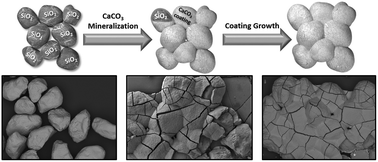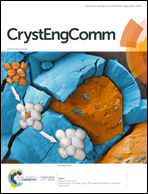Development of a novel CaCO3 PILP based cementation method for quartz sand†
Abstract
In this work, an aqueous calcium carbonate precursor solution capable of grouting loose quartz sand is developed and tested for the cementation of an Ottawa fine sand sample. Poly(acrylic acid) is used as a stabilizer of the CaCO3 liquid precursor phase resulting in homogenous droplets of the mineral precursor. Afterwards, this precursor phase was applied on quartz sand grains leading to calcium carbonate mineralization primarily on the surface of the grains. Within several days, a continuous CaCO3 coating of the sand grains was achieved (thickness of ∼50 μm), cementing the grains together forming a bulk material. This resulting composite material of CaCO3 cemented quartz sand is analogous to sandstone, which shows cohesion and enhanced strength with respect to untreated soil sand samples. The experimental procedures by which the required coating thickness forms have been thoroughly investigated and re-engineered in order to lay a foundation for an industrially applicable method in terms of upscaling and on-site construction. Investigations of the underlying mineralization process of this method strongly suggest a polymer induced liquid precursor (PILP) process followed by a non-classical crystallization pathway. Based on the observations made by TEM, SAED, AUC, DLS, and ATR-IR, a mineralization pathway for the coating formation is herein proposed.

- This article is part of the themed collections: Biomolecular crystal engineering and CrystEngComm 20th volume collection


 Please wait while we load your content...
Please wait while we load your content...